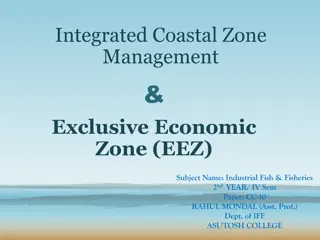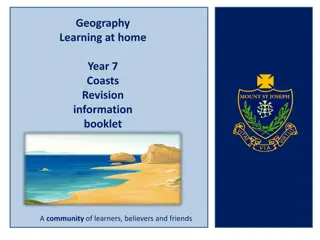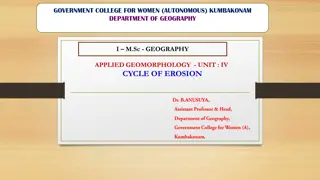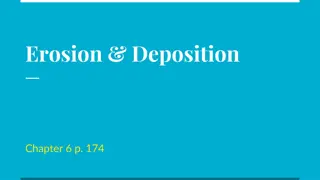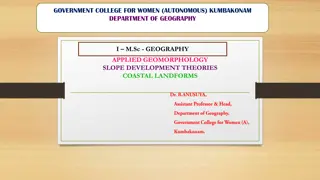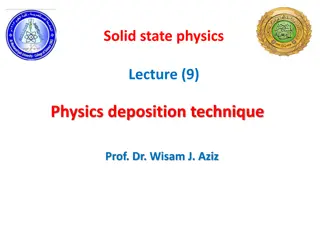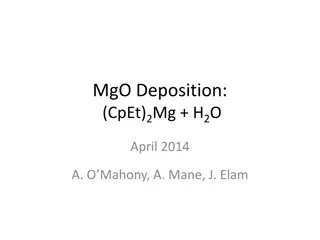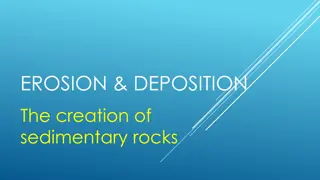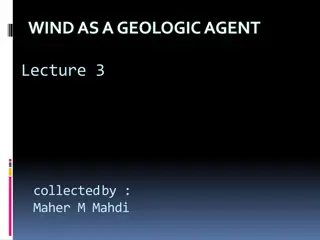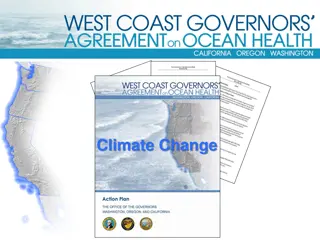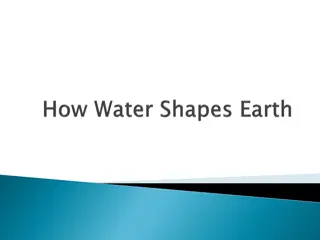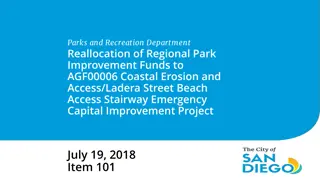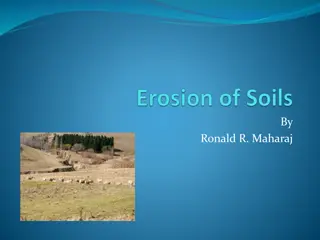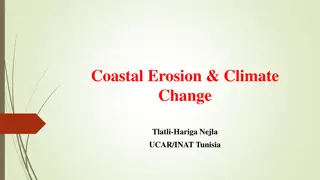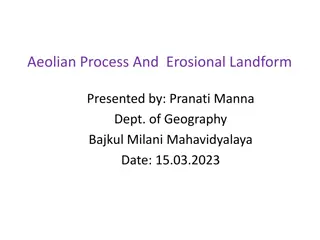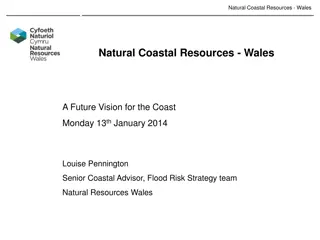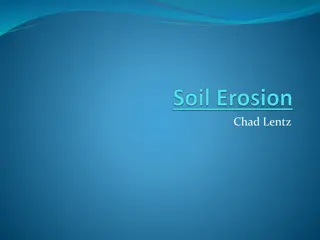Understanding Coastal Processes: Erosion, Deposition, and Human Impact
Coastal processes involve a complex interplay of erosion, deposition, and human activities that impact the dynamic equilibrium of coastlines. Energy from tides, waves, wind, and currents shape the land-water interface, while human use of coasts introduces conflicts leading to unstable systems. Sediment transport, flooding, accretion, and erosion are crucial elements affecting coastal zones, requiring study for sustainable development and management. Various mechanisms like beach nourishment, groin structures, and longshore transport play roles in shaping coastal landscapes.
Download Presentation

Please find below an Image/Link to download the presentation.
The content on the website is provided AS IS for your information and personal use only. It may not be sold, licensed, or shared on other websites without obtaining consent from the author. Download presentation by click this link. If you encounter any issues during the download, it is possible that the publisher has removed the file from their server.
E N D
Presentation Transcript
By Krishnaprasad V N M090160CE
Coastal processes are the set of mechanisms that operate along a coastline, bringing about various combinations of erosion and deposition. The land water interface along the coastline is always in a highly dynamic state and nature works towards maintaining an equilibrium condition. The energy due to tide, waves, wind and currents is constantly working in the coastal zone. Dissipation of energy (due to tide, wind, waves and current) is often provided by the beaches, mudflats, marshes and mangroves.
Human use of the coasts also requires space and herein lays the conflict, which results in unstable coastal systems. This induces coastal erosion, sediment transport and accretion. Coastal processes are highly unpredictable and is a challenge to coastal scientists. Some of the coastal processes are Sediment transport currents Denudation Deposition Erosion
Flooding Diffraction Refraction Sediment transport is the one of the important coastal process. The analysis and prediction of sediment transport have great commercial, aesthetic, importance owing to the sustainable development and coastal zone management. social, and scientific
accretion - natural or artificial deposition of sediment in a particular location beach nourishment - the restoration of a beach by the mechanical placement of sand on the beach for recreational and/ or shore protection purposes. cross shore transport - the displacement of sediment perpendicular to the shore erosion - the removal of sediment from a particular location by the action of wind or water.
groin - shore perpendicular structure, installed singly or as a field of groins, designed to trap sand from the littoral drift system . longshore transport (littoral drift) - the displacement of sediment down the shore (parallel to the shore). offshore transport - movement of sediment or water away from the shore
longshore bar - offshore ridge or mound of sand, gravel or other loose material running parallel to the shore which is submerged (at least at high tide) and located a short distance from the shore. tombolo - the combination of an offshore rock or island which is connected to the beach by a sand spit. sand spit - low tongue of land or a relatively long, narrow shoal extending from the land.
Gabions: Boulders and rocks are wired into mesh cages and usually placed in front of areas vulnerable to heavy to moderate erosion. onshore transport - movement of sediment or water toward the shore.
The offshore Nearshore Beach Coast
Changes in water level Tides Waves Currents Stream outflow
The areas, most directly affected by the forces of the sea are the beaches, the gulfs, and the nearshore zone regions that experience the full impact of the sea s energy. There are two general types of dynamic beach response to wave motion: Response to normal condition Response to storm condition
Normal condition prevail most of the time, and the wave energy is easily dissipated by the beach s natural defence mechanisms. When storm conditions generates waves containing increased amounts of energy, the extraordinary measures, such as sacrificing large section of beach and dune. coast must respond with Alternate erosion and accretion may be seasonal on some beaches; the winter storm waves erode the beach, and the summer waves rebuilds it.
Another transport nearshore zone by waves and currents. nearshore - the movement of sediments dynamical system is littoral in the Littoral transport is divided into two general classes: Longshore transport: Transport parallel to the shore. Onshore-offshore transport: Transport perpendicular to the shore.
Sediments are transported as, Bed load transport The bed load is the part of the total load that is more or less in contact with the bed during the transport. It primarily includes grains that roll, slide or bounce along the bed. experiment and theory suggest that the rate of bedload transport (qb) is proportional to the cube of the shear velocity, i.e. qb u*3 .A
Suspended load transport. It is the part of the total load that is moving in suspension without continuous contact with the bed. The determination of the rate of suspended load transport is straightforward by comparison with measurement of the rate of bedload transport. Wash load transport It consists of very fine particles transported in water.
It is the movement of sediments most often sand, along a coast parallel to its shoreline - sediment along the beach . a zig-zag movement of The largest beach sediment is found where the process begins, updrift, and the smallest, most easily moved, downdrift. Where waves are strong, the coast will be eroded and sediment carried away and where they are weak sediment will be deposited. Longshore drift can have undesirable effects for humans, such as beach erosion. To prevent this, sea defences such as groynes or gabions may be employed.
Where beaches have become severely eroded by longshore drift and little material is replaced by natural processes, then the material may be artificially replaced by beach nourishment. Net rate: Gross rate:
Model theories for the calculation of longshore drift are Energy flux model Energetic model Suspended transport model
It is the simplest model used for the calculation of total amount of material moved along the shoreline. It is based on the amount of energy available in the waves arriving at the shoreline. The flux energy in the wave direction is determined to be as dl, where -the energy flux of the waves per unit crest width( =ECg), E - the energy per unit surface area= gH2/8 the water density
g-acceleration due to gravity Cg-Group velocity To determine the amount of this energy flux per unit length of coastline consider the figure,
dx=dl/cos, where is the angle the wave ray makes with the onshore(y)direction. Now it is supposed that the energy flux in the alongshore direction is responsible for the longshore sediment transport; therefore we multiply the energy flux per unit legth(dx=unity) of beach by sin to obtain cos sin = Pl=ECgsin cos = ( gCgsin2 )/16
For many years this alongshore energy flux per unit length of beach,Pl was correlated empirically with the volume sand moved by the waves. Amount material moved, Q= CPnl..................................................................................B Where C is a dimensional constant of proportionality. The power n has been found to be close to unity. equation A as being dimensionally incorrect. Then corrected the equation as Q=KPl/[( s- )g(1-p)]
Where -p is the porosity of the sediment, which is typically about .3 to .4. the porosity is introduced to convert sand weight to sad volume, taking into account the voids that occur with in the sand. K-is the dimensionless parameter, its value ranging from 0.2 to 2.
Longshore sediment transport rate (LSTR) reported for different locations along the Indian coast reversals in the transport direction in a number of locations along the west coast. shows local It was found that the annual gross sediment transport rate was high ( 1 * 106m3) along the coast of south Orissa and south Kerala.
Location Net transport Gross transport (m3/yr) West coast of India Kalbadevi 118,580 Ambolgarh 189,594 Vengurla 53,040 Calangute 90,000 Colva 160,000 Arge 69,350 Gangavali 142,018 Kasarkod 40,186 Maravanthe 25,372 (m3/yr) South 147,621 South 299,997 South 120,141 South 120,000 North 160,000 North 200,773 South 177,239 North 77,502 North 29,836
Kasargod 736,772 19,434 114,665 192,818 202,096 16,929 383,784 South South South North South North South North West 958,478 561,576 256,697 660,276 599,484 62,519 805,296 1231,153 946,500 Kannur Kozhikode Nattika Andhakaranazhi Alleppey Kollam Thiruvananthapuram 99,159 Kolachel 302,400
East coast of India Ovari Tiruchendur Kannirajapuram Naripayur Muthupettai Poompuhar Pondichery Periyakalapet Tikkavanipalem Gopalpur Prayagi Puri 1,500 64,100 117,447 36,600 5,200 146,000 134,400 486,900 177,000 830,046 887,528 735,436 South North North South South North North North North North North North 251,300 87,500 145,979 122,500 8,900 478,800 237,000 657,600 405,000 949,520 997,594 926,637
Cross shore transport is a result of the water motions due to the waves and the undertow. Here the sediment transport is perpendicular to the shore. Important factors in determining the cross-shore transport of sand are The ratio of wave height to wavelength Physical parameters of the beach; i.e., grain-size distribution, cohesiveness, beach slope also play an important role.
Model theories for the calculation of Onshore-offshore transport drift are Simple cross shore transport model Fall time model Traction model for cross shore transport Energetics model Ripple model
This model was first proposed by Moore and later modified by Kriebel and Dean. The basic concept is that, for a uniform sand size across the profile and an equilibrium beach, there is a constant energy dissipation rate per unit volume. It is assumed that the amount of sediment moved will be dependent on the difference between the actual energy dissipation rate and that for an equilibrium profile D*. qs= K(D- D*.) where qs is the volumetric cross shore sediment transport rate per unit width in the offshore direction and K is a new dimensional constant.
If D is greater than equilibrium value greater turbulence level in the surf zone than that of for the equilibrium profile. If qs is positive then there will be a sediment transport in the offshore direction. On the other hand , for values of less than equilibrium value, onshore transport will occur. The value obtained as, D = (5 gk2(gh)0.5dh/dy)/16 D* there is a D can be which is dependent on the water depth and bottom slope, which has stronger effect.
Onshore offshore drift and longshore drift deposit and shape debris to produce a variety of landforms. A spit is an elongated deposit that extends from the land edge out to sea. It may be shaped to produce a distinctly curved end, as in Cape Cod. Another landform that attaches an island to the mainland is known as a tombolo, while deposits may also accumulate to create barriers such as a bay barrier.
Excellent recent examples of seasonal cross-shore transport and the resultant change in beach profile, -Imperial Beach, La Jolla, and Carlsbad.
Coastal engineers, physical oceanographers and geomorphologists generally carry out measurements of sediment transport using the following methods : Wave refraction studies Determines places of wave convergence or divergence and provide quantitative measurement. Using geomorphic indicators Based on geomorphic indicators sediment transport direction is decided.
Sedimentological methods. Beach profile study, sediment budget measurement. Sediment trap study Suspended sediments are collected in sediment trap and are measured Artificial tracer tracking Sediment transport direction detected from the movement of artificial tracers.
Coastal processes are highly unpredictable and is a challenge to coastal scientists. Coastal processes are important in the case of Prediction of environmental quality and impact Habitat stability, Public health risks, Marine hazards such as ship grounding Access to ports, seabed scouring
Siltation of harbours, infill of reservoirs and artificial lakes And in coastline protection. It is very crucial to understand the nearshore physical system, the consequent impact on sediment dynamics, and the coastline s response to it.
Robert G.Dean &Robert A.Dalrymple,Coastal processes with engineering applications,2002,04. Walton Jr., T. L. and Bruno, R. O., Longshore transport at a detached break water, Phase II. J. Coast. Res., 1989, 5, 679 691. U.S corps engineers, Coastal engineering manual. www.googlebooks.com
This powerpoint was kindly donated to www.worldofteaching.com http://www.worldofteaching.com Is home to well over a thousand powerpoints submitted by teachers. This a free site. Please visit and I hope it will help in your teaching



